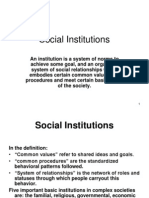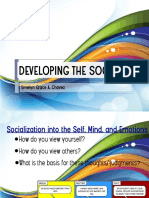Charles Horton Cooley
Charles Horton Cooley
Uploaded by
zainabCopyright:
Available Formats
Charles Horton Cooley
Charles Horton Cooley
Uploaded by
zainabOriginal Description:
Original Title
Copyright
Available Formats
Share this document
Did you find this document useful?
Is this content inappropriate?
Copyright:
Available Formats
Charles Horton Cooley
Charles Horton Cooley
Uploaded by
zainabCopyright:
Available Formats
CHARLES HORTON COOLEY
Charles Horton Cooley was born August seventeen, 1864, in city, Michigan. C.H Cooley was a
sociologist who wished to better perceive society and human behavior. He believed that the
influence of groups inside a society had a robust impact on human behavior.
Cooley's one of the most important contribution to sociology was the study of primary groups.
Cooley coined the term 'primary group,' which means that this can be the primary group one is
introduced to and is that the most important on our learning of concepts, beliefs and ideals.
When observing society, Cooley noticed that the more society became industrialised, the more
individualistic the members became. He saw that the folks became more distant from one
another, more competitive and were losing the association to ancient family values that of
community. It had been through his study of primary groups that Cooley hoped to achieve
more social unity and cohesiveness.
Cooley is one amongst the founders of the interactionist perspective, that seeks to elucidate
society by observing the everyday sorts of interaction between people. Cooley's theory of self is
one during which we tend to learn who we are through our interactions with others. This can
be referred to as the looking glass self.
Cooley : Looking-Glass Self In the early 1900s, Cooley advanced the belief that we learn
who we are by interacting with others. Our view of ourselves, then, comes not only from direct
contemplation of our personal qualities, but also from our impressions of how others perceive
us. Cooley used the phrase looking-glass self to emphasize that the self is the product of our
social interactions with other people.
The process of developing a self-identity or self-concept has three phases. First, we imagine
how we present ourselves in front of others, relatives, friends, even strangers on the street.
Then we imagine how others evaluate us. Finally we develop some sort of feeling about
ourselves, such as respect or shame, as a result of these impressions.
A critical but subtle aspect of Cooley’s looking-glass self is that the self results from an
individual’s “imagination” of how others view him or her. As a result, we can develop self-
identities based on incorrect perceptions of how others see us. A student may react strongly to
a teacher’s criticism and decide that the instructor views the student as stupid. This
misperception can easily be converted into a negative self-identity through the following
process: (1) The teacher criticized me, (2) The teacher must think I am stupid, (3) I am stupid.
Yet self-identities are also subject to change. If the student above received an ‘A’ at the end of
the course, he or she might no longer feel stupid.
You might also like
- Session 2 Understanding Growth and DevelopmentDocument39 pagesSession 2 Understanding Growth and DevelopmentDaniphine A. BaduaNo ratings yet
- The Self From Psychological Perspectives PDFDocument45 pagesThe Self From Psychological Perspectives PDFRigine Pobe Morgadez100% (2)
- Cooley Looking Glass SelfDocument13 pagesCooley Looking Glass SelfFlorina Nadorra Ramos100% (1)
- Positive School of CriminologyDocument65 pagesPositive School of CriminologyMohandas Periyasamy100% (1)
- Ch. 3-4 ReviewDocument4 pagesCh. 3-4 RevieweNo ratings yet
- Charles Horton Cooley Looking Glass SelfDocument5 pagesCharles Horton Cooley Looking Glass SelfShaina Bagacina Oriol100% (1)
- Social Cognitive TheoryDocument5 pagesSocial Cognitive TheoryyugeszNo ratings yet
- The Topographic ModelDocument7 pagesThe Topographic ModelAbhipsa SarkarNo ratings yet
- Mind, Self and Society - Socio-1Document28 pagesMind, Self and Society - Socio-1kurou hazamaNo ratings yet
- Meaning of Human DevelopmentDocument2 pagesMeaning of Human DevelopmentAmaiEden100% (1)
- Realism and EducationDocument39 pagesRealism and EducationBea MartirezNo ratings yet
- Activity 4 Physical SelfDocument4 pagesActivity 4 Physical SelfLACONSAY, Nathalie B.No ratings yet
- Social InstitutionsDocument18 pagesSocial InstitutionsMaham Farrukh ChaudharyNo ratings yet
- Chapter Iii: Managing and Caring For The Self A. Learning To Be A Better StudentDocument12 pagesChapter Iii: Managing and Caring For The Self A. Learning To Be A Better Studentzed cozNo ratings yet
- Do You Agree That There Is A Difference Between The Body and The Soul?Document13 pagesDo You Agree That There Is A Difference Between The Body and The Soul?Carmelita VolanteNo ratings yet
- The Self From The Anthropological PerspectivesDocument9 pagesThe Self From The Anthropological PerspectivesSean Misola GacuyaNo ratings yet
- Sociology EssayDocument3 pagesSociology EssayLarissa BishopNo ratings yet
- The Self According To The Perspective of AnthropologyDocument1 pageThe Self According To The Perspective of AnthropologyJohn RivasNo ratings yet
- Philosophical Perspective of The SelfDocument21 pagesPhilosophical Perspective of The SelfJannah FateNo ratings yet
- How Globalized Is The Philippines Using The Index of Globalization?Document5 pagesHow Globalized Is The Philippines Using The Index of Globalization?Francine Angelika Conda TañedoNo ratings yet
- Unit Concepts and Forms of Social Mobility: ObjectivesDocument52 pagesUnit Concepts and Forms of Social Mobility: ObjectivesHarish KumarNo ratings yet
- Education As Factor of Social ChangeDocument2 pagesEducation As Factor of Social Changelaljoel100% (4)
- USELFModule 3. Unfolding The Mental SelfDocument19 pagesUSELFModule 3. Unfolding The Mental SelfChocolate CheeksNo ratings yet
- The Relationship Between School and Society - Part II - Conflict TDocument3 pagesThe Relationship Between School and Society - Part II - Conflict TAmirah HusnaNo ratings yet
- Lesson 3 Anthropological Perspective of The SelfDocument18 pagesLesson 3 Anthropological Perspective of The SelfGugel AkawntNo ratings yet
- Id, Ego and Super EgoDocument10 pagesId, Ego and Super EgoMarichelle Ann CahiligNo ratings yet
- Characteristics & Related Terms of CultureDocument32 pagesCharacteristics & Related Terms of CultureEloisa BrailleNo ratings yet
- GEC 1 Chapter 1Document24 pagesGEC 1 Chapter 1Kacey AmorNo ratings yet
- Reporting EthicsDocument17 pagesReporting EthicsJabe neyNo ratings yet
- Factors Influencing Child DevelopmentDocument42 pagesFactors Influencing Child Developmentmiji_ggNo ratings yet
- Chapter I: The Self From Various Perspectives C. AnthropologyDocument6 pagesChapter I: The Self From Various Perspectives C. Anthropologyi'm MNo ratings yet
- George Herbert MeadDocument11 pagesGeorge Herbert MeadSuman AgrawalNo ratings yet
- Chapter I: The Self From Various Perspectives D. Psychology: Module OverviewDocument4 pagesChapter I: The Self From Various Perspectives D. Psychology: Module Overviewi'm MNo ratings yet
- Chapter 1 - Nature of SelfDocument6 pagesChapter 1 - Nature of SelfSharmaine Gatchalian BonifacioNo ratings yet
- CHAP1 - Undrestanding The SelfDocument37 pagesCHAP1 - Undrestanding The SelfPathy May100% (1)
- Self in A Social WorldDocument36 pagesSelf in A Social WorldGiofanny Jessica100% (1)
- Theory & Research: © 2012 by The Mcgraw-Hill Companies, IncDocument57 pagesTheory & Research: © 2012 by The Mcgraw-Hill Companies, IncIkram AhmadNo ratings yet
- From The Perspective of SociologyDocument22 pagesFrom The Perspective of SociologyJohanifa Indar BanisilNo ratings yet
- Further Schools of Thought in Psychology Chapter 5 LenseDocument7 pagesFurther Schools of Thought in Psychology Chapter 5 LenseCarlos DelgadoNo ratings yet
- Social ConformityDocument18 pagesSocial ConformitySahilPrabhakarNo ratings yet
- 2 Dilemma and Foundation of MoralityDocument11 pages2 Dilemma and Foundation of MoralityAbcd ReyesNo ratings yet
- Uts Lesson 3Document7 pagesUts Lesson 3Celina Jane MagpantayNo ratings yet
- Education, Culture and SocietyDocument49 pagesEducation, Culture and Societyalexia.roman.cvNo ratings yet
- The Self As Cognitive Construct: Xides Leonore P. Conwi, LPTDocument33 pagesThe Self As Cognitive Construct: Xides Leonore P. Conwi, LPTCristine BalocaNo ratings yet
- Lesson 3 StudentDocument38 pagesLesson 3 StudentZane James SebastianNo ratings yet
- Sociological - Self - Edit 2Document27 pagesSociological - Self - Edit 2Jade Harris Colorje100% (2)
- Developing The Social SelfDocument27 pagesDeveloping The Social SelfGrace CaritNo ratings yet
- Lesson 4. From The Perspective of PsychologyDocument47 pagesLesson 4. From The Perspective of PsychologyZairyl Jake NazaireNo ratings yet
- Henna PPT Moral DevlpDocument24 pagesHenna PPT Moral Devlpmuhammad usman munawarNo ratings yet
- Enhanced Syllabus Format - Gender and SocietyDocument22 pagesEnhanced Syllabus Format - Gender and SocietyAsyed Silayan ZaportizaNo ratings yet
- Basic Social Institutions: EducationDocument24 pagesBasic Social Institutions: EducationGeofel Lumasag PalanasNo ratings yet
- Theories of Community DevelopmentDocument28 pagesTheories of Community DevelopmentAsta BlackNo ratings yet
- Lesson 3: The Self From The Perspective of Anthropology Anthropology Biological AnthropologyDocument3 pagesLesson 3: The Self From The Perspective of Anthropology Anthropology Biological Anthropologyblackmasque100% (1)
- Learning Activity 1: Stand Points On Philosophers PhilosophyDocument5 pagesLearning Activity 1: Stand Points On Philosophers PhilosophyJeanette Torralba Esposito100% (1)
- 2PROF ED 02 Activity SheetDocument10 pages2PROF ED 02 Activity Sheetairen bandolaNo ratings yet
- Chapters 2-5 (Understanding The Self)Document21 pagesChapters 2-5 (Understanding The Self)Jovina M SinggonNo ratings yet
- Communication As An Element of CultureDocument21 pagesCommunication As An Element of CultureOana Alexandru100% (3)
- Slides - Social Interaction and Socialization - July2020Document46 pagesSlides - Social Interaction and Socialization - July2020sojibNo ratings yet
- PP Behaviourism Vs CogntivismDocument18 pagesPP Behaviourism Vs CogntivismKannah SureshNo ratings yet
- Difference Between Social Science and Social StudiesDocument3 pagesDifference Between Social Science and Social StudiesReynaldo Cantores Seidel Jr.No ratings yet
- Educating Through Pandemic: Traditional Classroom Vs Virtual Space - the Education RealmFrom EverandEducating Through Pandemic: Traditional Classroom Vs Virtual Space - the Education RealmNo ratings yet
- LAP 4 Facilitating Learner Centered TeachingDocument8 pagesLAP 4 Facilitating Learner Centered TeachingJheizeiryl GaidNo ratings yet
- The Effect of Perceived Organizational Support and Employee Engagement On Readiness To ChangeDocument4 pagesThe Effect of Perceived Organizational Support and Employee Engagement On Readiness To ChangeRobby PrakosoNo ratings yet
- The Sex SecretDocument77 pagesThe Sex Secretanh7codon100% (3)
- Chapter 9Document5 pagesChapter 9Mr. John TettehNo ratings yet
- Spiritual Leadership - and Job SatisfactionDocument7 pagesSpiritual Leadership - and Job SatisfactionSabitha AnsifNo ratings yet
- Logical FallaciesDocument2 pagesLogical FallaciesRupasari_MuraiNo ratings yet
- Stage of Pinoy in The OrganizationDocument23 pagesStage of Pinoy in The OrganizationAcPantinoNo ratings yet
- Country Comparison - Hofstede Insights PDFDocument8 pagesCountry Comparison - Hofstede Insights PDFnugrahani indra suwartoNo ratings yet
- Alternatives To ExperimentationDocument29 pagesAlternatives To ExperimentationNikka TanakaNo ratings yet
- Organizing: Engineering ManagementDocument7 pagesOrganizing: Engineering Managementsha mNo ratings yet
- Bsbcmm101a R1Document7 pagesBsbcmm101a R1sandi purbaNo ratings yet
- Article 2 PDFDocument8 pagesArticle 2 PDFTito Setiawan NugrohoNo ratings yet
- Husserl, E. (1924) 1974, Kant and The Idea of Transcendental PhilosophyDocument49 pagesHusserl, E. (1924) 1974, Kant and The Idea of Transcendental PhilosophykhrinizNo ratings yet
- The Clientele and Audiences of CounselingDocument11 pagesThe Clientele and Audiences of CounselingRicardo Acosta Subad73% (11)
- Leadership Final PaperDocument7 pagesLeadership Final Paperapi-500286673100% (1)
- Ego State Therapy: Gordon EmmersonDocument16 pagesEgo State Therapy: Gordon EmmersonHendro Santoso0% (2)
- The Four Types of MisbehavioursDocument2 pagesThe Four Types of MisbehavioursLords PorseenaNo ratings yet
- Wild and Isolated ChildrenDocument10 pagesWild and Isolated ChildrenJameliaNo ratings yet
- The Leadership Quarterly: Myriam Chiniara, Kathleen BenteinDocument18 pagesThe Leadership Quarterly: Myriam Chiniara, Kathleen Benteinvivi nauraNo ratings yet
- Maysan Road, Valenzuela City Relationship Management and Road Safety - Prelims ExaminationDocument4 pagesMaysan Road, Valenzuela City Relationship Management and Road Safety - Prelims ExaminationAshley Niña Lee HugoNo ratings yet
- Syllabus For Painting 1 ClassDocument2 pagesSyllabus For Painting 1 Classapi-249667332No ratings yet
- Nature of Different Recreational ActivityDocument13 pagesNature of Different Recreational ActivityMarjun SalinasNo ratings yet
- Understanding Self OBE InfoDocument5 pagesUnderstanding Self OBE InfoManiya Dianne ReyesNo ratings yet
- BLOOMS TaxonomyDocument15 pagesBLOOMS Taxonomycoolkanna100% (1)
- Developing Receptive SkillsDocument21 pagesDeveloping Receptive Skillsrodrigo gonzalez100% (7)
- Implication of External and Internal Factors of Mall Consumers in Indonesia To Impulsive Buying BehaviorDocument10 pagesImplication of External and Internal Factors of Mall Consumers in Indonesia To Impulsive Buying BehaviorAditya TroJhanNo ratings yet
- Exploring Vietnamese Students' Attitude Towards Project Works in Enhancing Autonomous Learning in English Speaking ClassDocument23 pagesExploring Vietnamese Students' Attitude Towards Project Works in Enhancing Autonomous Learning in English Speaking ClassAmadeus Fernando M. PagenteNo ratings yet

























































































